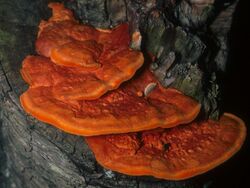Biology:Pycnoporus cinnabarinus
From HandWiki
Short description: Species of fungus
| Pycnoporus cinnabarinus | |
|---|---|

| |
| Scientific classification | |
| Domain: | Eukaryota |
| Kingdom: | Fungi |
| Division: | Basidiomycota |
| Class: | Agaricomycetes |
| Order: | Polyporales |
| Family: | Polyporaceae |
| Genus: | Pycnoporus |
| Species: | P. cinnabarinus
|
| Binomial name | |
| Pycnoporus cinnabarinus (Jacq.) P.Karst. (1881)
| |
| Synonyms | |
| |
| Pycnoporus cinnabarinus | |
|---|---|
| Mycological characteristics | |
| pores on hymenium | |
| hymenium attachment is not applicable | |
| lacks a stipe | |
| ecology is saprotrophic | |
| edibility: inedible | |
Pycnoporus cinnabarinus, also known as the cinnabar polypore, is a saprophytic, white-rot decomposer. Its fruit body is a bright orange shelf fungus. It is common in many areas and is widely distributed throughout the world. It is inedible.[1] It produces cinnabarinic acid to protect itself from bacteria.[2]
The stipe and the pore surface had a positive reaction with potassium hydroxide.
References
| Wikimedia Commons has media related to Pycnoporus cinnabarinus. |
- ↑ Phillips, Roger (2010). Mushrooms and Other Fungi of North America. Buffalo, NY: Firefly Books. p. 304. ISBN 978-1-55407-651-2. https://archive.org/details/mushroomsotherfu0000phil.
- ↑ Eggert C. Laccase-catalyzed formation of cinnabarinic acid is responsible for antibacterial activity of Pycnoporus cinnabarinus. Microbiol Res. 1997;152(3):315-318. doi:10.1016/S0944-5013(97)80046-8
Wikidata ☰ Q205101 entry
 |

